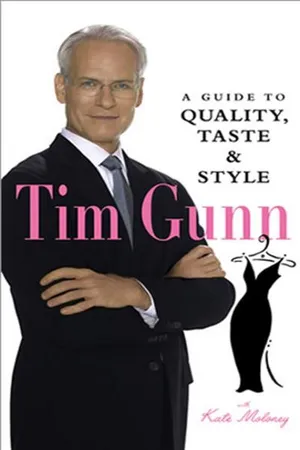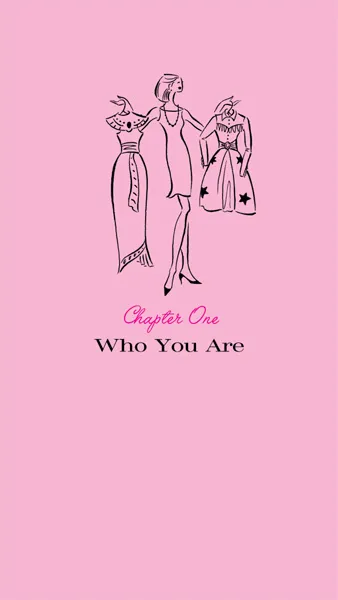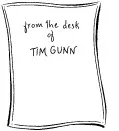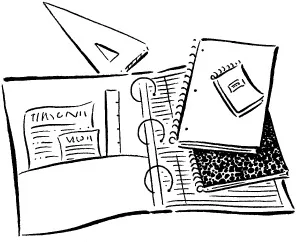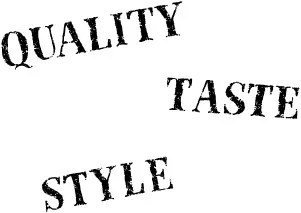![]()
The Lesson: Understanding and acknowledging who you are is the most important key to the content of your wardrobe. If you consider your wardrobe to be a sphinx, then the sphinx’s riddle is surely, “who are you?” Only you possess the answer. Who you are can take us down the longest metaphysical road, so try not to get swept up in too much brooding self-examination and analysis. This doesn’t have to be daunting. In fact, we believe this book can make it fun.
“Know, first, who you are;
and then adorn yourself accordingly.”
—Epictetus
A NOTE BEFORE WE BEGIN
Dressed in white slacks and an off-the-shoulder sweater, Diane von Furstenberg uses an asparagus spear to tidy the couscous left on her lunch plate. We’re sitting amidst Moroccan serving platters of marinated chicken and green salad at the gorgeous and exotic dining table in her enormous loft in the far West Village. She looks up at me and declares, “Tim, you must never lose your voice as an educator.” That was her response when I first told her about this book, and it has resonated in me during each and every day of writing. Diane is a dear friend and colleague, and a huge supporter of design education. She is a wise counsel, an oracle, and I adore her for her always frank conversations and occasional outbursts of tough love.
This book is not intended to be an oracle, but it is intended to offer wise counsel and, I hope, inspiration. The centerpiece of the book is you, the reader. I ask that you rid yourself of boundaries and barriers in order to truthfully examine who you are and what your lifestyle is like with the same directness and tough love that Diane von Furstenberg extended to me. This book doesn’t want to change you. You are who you are for a reason. I want the content of this book to enhance you, accentuating your positive aspects and mitigating your negative ones.
Unlike the designers I work with on television and my students at Parsons, you and I are not face to face. So don’t harbor any concerns that I’m going to stare you down with shock or incredulity. I’ll let you do that! The goal of this book is to provide you with the tools for an honest self-analysis. I want you to have an epiphany; that is, a moment when reading or reflecting that causes you to emit, “Eureka! I get it!” After your self-awareness is honed, then any actions in response to your epiphany are owned by you.
QUALITY, TASTE & STYLE
“Quality, Taste, and Style,” is my operative tenet for most of what I do. It’s another way of saying, “The Best.” I aim to achieve that in everything from my work at Parsons to my critiques of the designers on television to fixing a meal or cleaning my apartment. Why take on an endeavor if you’re not committed to doing your best? I hope to inspire you to better understand your own standards for quality, taste, and style, as defined by you.
None of this is easy. It requires commitment and discipline. While writing, I was constantly examining myself and took both pain and pleasure when putting to practice my own advice. Just this morning, I found myself presented with a clothing dilemma. In preparation for a ten-day trip, I had several suits and many shirts at the dry cleaner that wouldn’t be ready for another day. A heavy wool suit loomed at me, but it was inappropriate for this unseasonably warm late-October day. My black suits struck me as being too dressy for those with whom I would engage, so separates—pants, sportcoats—seemed to be the answer. It struck me that a closet isn’t a clothing store. It’s a collection of items that reside there for the purpose of being chosen—or not. So why is it that I so frequently ponder and search, but come up empty, declaring, “I’ll need to shop for X so that this dilemma can be reconciled”? That’s the wrong approach. The correct approach is to make it work! I merely need to take my own medicine!
MAKE IT WORK!
“Make it work!” is an enormously useful expression. I remember the first time I used it. It was roughly six years ago in one of my classes at Parsons. I find that often students who struggle with an assignment are inclined to abandon the struggle and begin again. This practice unnerves me, because it’s like playing roulette with one’s work. What assurance does one have that the next spin of the wheel will be successful? Important learning occurs when a struggle is examined and analyzed, diagnosed, and a prescription offered. Ergo, make it work. I believe that we all benefit from the make-it-work practice.
So I suggest that we all come to terms with what fashion looks we gravitate toward and then analyze them for their particulars: items of apparel, color stories, accessories, even hair and makeup. Think of this process as being like playing with Colorforms. The items of apparel and accessories are discreet components designed to be mixed and matched. You’re selecting and placing them on an image of you, so take into account your coloring, your height, and your silhouette. Look carefully at the proportion of the clothes in relation to your body and the proportions of each item in relation to the others. Where does the skirt’s hem end on your leg? What about the jacket’s shoulders and arm length? Where does the jacket hit the skirt? With each and every addition of an item, silhouette and proportion change. Be attentive to these myriad moving parts! Start asking these questions and more: Which fabrics do you feel most comfortable in? How do you accessorize? Where do you shop? What does your carriage say about you?
MILIEU AND ITS ATTENDANT EXPECTATIONS
Notice that this chapter is not titled “Who Are You?” That question strikes me as being quasi-confrontational. I’m reminded of the chilling scene in The Wizard of Oz when Dorothy, the Scarecrow, the Tin Man, and the Cowardly Lion stand before a stage of fire and brimstone, replete with voluminous clouds of spewing smoke. An apparition, the hydrocephalic emerald green Wizard, bellows at them, “Who are you?!” in a manner that challenges their mere existence. I love the fact that you exist!
Who you are embraces everything about you, from your family’s origins to your predilections for particular films and music, to your fantasies and reveries, to your weekly routines. It’s also your size, shape, and proportions, and your coloring. And it’s the city or town in which you live, your home, and your friends and colleagues. It’s milieu.
With milieu comes attendant expectations. How we dress sends a message about who we are, or at least how we want the world to perceive us. It’s the semiology of clothes. Although I’m not a fan of Roland Barthes, I do subscribe to his theory that language is a self-contained system of signs. How we dress is a personal form of language; it is highly informed by our society and culture. So, as you face your wardrobe and prepare to dress for the day, project yourself onto a billboard in Times Square. How will people respond to that image of you, and what assumptions will they make about who you are?
While I acknowledge that who I am is a synthesis of my genetic makeup, my upbringing, my education, and my life experience, when I seriously home in on the essence of me, it’s my professional life that defines me. Although a New Yorker for close to a quarter of a century, my sartorial roots are in Washington, D.C.
I love my hometown, but let’s be honest, with the exception of the dazzling Kennedy years, Washington is a fashion desert. When I was younger, Brooks Brothers was my haberdasher of choice, and while I respect its market, it’s hardly fashion forward. As a struggling sculptor in D.C., I survived by building architectural models and had a wardrobe of jeans, khakis, and T-shirts, which was appropriate enough. Later, I began teaching three-dimensional design at the Corcoran, so I paired the jeans and khakis with button-down oxford shirts. When I began working in the Corcoran’s Office of Admissions, I traveled nationwide to recruit students, so I added neckties and a navy blazer to my wardrobe. Later still, with more maturity and responsibility, I added suits—my favorite at that time being a gray glen plaid. When I accepted a position at Parsons and moved to New York in 1983, the D.C. wardrobe followed. I wore it with no regard for the fashion circus that is New York. I wasn’t out of place, because you can wear anything in the City That Never Sleeps, but I wasn’t acknowledging the expanded possibilities that the city provided for my wardrobe, either. But, eventually, I did add Ralph Lauren to my vocabulary, partially because their flagship at 72nd Street and Madison Avenue is one of the most spectacular interiors on earth. Who wouldn’t want to visit?!
For years and years, I was Associate Dean at Parsons. In that capacity, I wore a suit and tie every day—gray, grayer, and grayest. Frankly, it wasn’t until my position at Parsons shifted to Chair of the Department of Fashion Design—temporarily I thought—that I came to sobering terms with who I am. It was sobering, indeed, to look at myself objectively and see a stuffy, buttoned-up old fart. I became very aware of Donna Karan’s glares, Marc Jacobs’s snickers, and Diane von Furstenberg’s slight sniffs of disdain. Whether the position was temporary or not, I needed to be modernized. Still, I hesitated. But when I received a permanent appointment a year later . . . I went shopping! My goal was to find a black leather blazer. Why? Because it’s hip and therefore modern, yet the soul of the blazer is, by definition, conservative.
Look, I am only too cognizant of the fact that I am not a Dolce & Gabbana or Dsquared2 kind of guy, so a leather blazer was an excellent transitional piece for me. I found a great one at Saks. It was Hugo Boss and it was—gulp—
800. I loved it. I bought it. And I left Saks in a retail daze, because
800 was my clothing budget for the year. I crossed Fifth Avenue to Rockefeller Center and stumbled into Banana Republic. I recognized that I was in a stupor, but I believed that I spotted a black leather blazer identical to the one I just bought. Was that possible? I moved forward and, sure enough, it was entirely possible. More important, the blazer was only
400! I bought it. I even opened a Banana Republic account and saved 20 percent, too. Then, I crossed Fifth Avenue, again, to return the earlier purchase. I was so proud of myself: mission accomplished and at a 50 percent savings! Most notable for me was that with that blazer, I experienced for the first time and first-hand the incredible virtues of black: It’s sophisticated, slimming, and always in style. Furthermore, you don’t have to think about “does this go with that?” It’s black. It goes. So now I have a closet filled with black suits, black jackets, black shirts, black sweaters, and black shoes. I can’t go back from black!
I’m not advocating that you wear the same thing in the same color day after day, but most of us are comfortable with a uniform. By “uniform,” I don’t mean a Stepford Wife blueprint of exacting sameness. I mean a cache of categories of separates that can successfully interact. My mother is constantly asking me how it can be that I wear so much black, adding, “And how many black turtlenecks must you own?” I know what I’m confident wearing, because I know that these articles of apparel look good on me. I’d say that I have five or six looks and iterations thereof. This makes selecting a look for the day a fairly easy exercise for me. I look at my itinerary, see which appointments I have and with whom, and dress for the highest level of expectation for that day.
I believe that most of us think the same way about our wardrobe; that is, we like having a uniform. Not one uniform, but a number of various looks, the components of which can be mixed around and accessorized. It’s essential that you identify looks—not merely items of clothing, but combinations that will be worn together: the silhouettes, proportions, colors, and textures of which flatter and enhance you. Then, stick with them! Do not stray! And don’t ever forget about fit!
Never forget that fashion, your fashion, cannot be comprehensively assessed without projecting it onto you; you need to try clothes on and look at yourself (and I prefer a three-way mirror for this purpose). When speaking about fashion and proportion, proportion includes the relationship between the clothes and your body; that is, what proportion is created between the hem of your skirt a...
